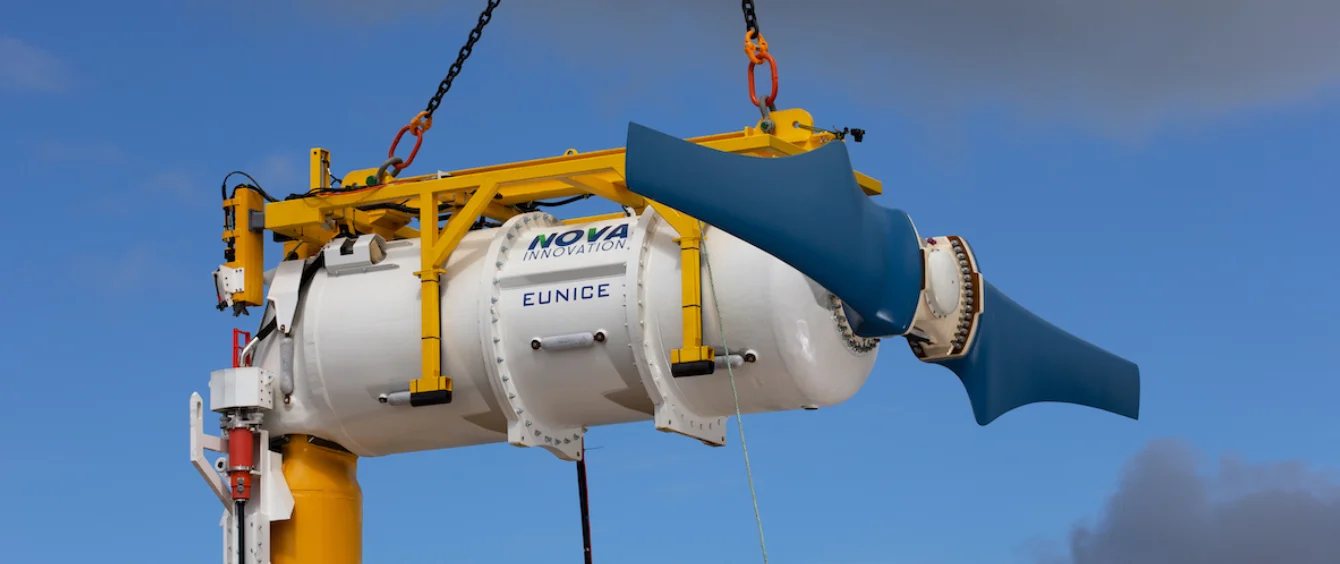Anyone who has ever battled the waves at a beach knows only too well the unbridled power of the sea. And yet the energy of the waves is nothing compared to that of the tides, and mankind has harnessed this energy for centuries. Most tactics have followed the same basic principle: the water is impounded at high tide, and then, at low tide, released through a system which harvests the energy. In the past, this involved the use of paddle wheels in mills; today it is turbines that generate electricity. Modern tidal power plants also harness the incoming tide to generate power.
However, implementing this system economically is not that simple. Only six tidal power stations are currently in operation around the world. Although other suitable sites do exist, they are few and far between, come with considerable price tags and can impact the local environment.
Propeller rather than dam
But there is another way to convert tidal energy into electricity – based on a simple principle, strongly reminiscent of wind power: the ocean current drives a propeller, connected to a generator. These turbines are installed on structures anchored to the seabed. The only difference is they don’t protrude out of the water, but instead rely on powerful currents on the ocean floor, flowing in one direction on a flooding (high) tide, and in the opposite direction on an ebbing (low) tide.
As with all tidal power plants, their supply is extremely reliable. Granted, the strength of the current is not always the same. It varies from one location to the next and also depends on factors such as the phase of the moon and the relative position of the sun. But this form of energy is reliable in that it can be predicted very accurately down to the day and even the hour – and that years in advance. This is invaluable not only for grid stability, but also for planning certainty and thus for financing costs.
Scotland: a hotbed of innovation
It is no coincidence that two companies making a name for this technology are based in the Scottish capital, Edinburgh. The British Isles are particularly exposed to the tides. North of Scotland, the water masses flow from the North Sea into the North Atlantic and back. Conditions are particularly favourable between the islands of Shetland and Orkney.
It is precisely here, between the two main northern islands of Shetland, Unst and Yell, at Bluemull Sound that the company Nova Innovation installed the fourth of a total of six turbines in October 2020. With these turbines, the European consortium EnFAIT intends to demonstrate how a tidal power plant of this type can be built, operated and dismantled using this technology by 2022. Not to mention that it can also be used to supply electricity at market prices.
And this is precisely what EnFAIT appears to have achieved thanks to the recently installed ‘Eunice’ turbine with a maximum output of 100 kilowatts (kW). Thanks to a new gearless turbine, costs have allegedly been cut by a third, meaning its output can now compete with conventionally generated electricity. Eunice now supplies enough electricity for around 40 average British households. Moving forward, larger turbines and greater production volumes are expected to reduce costs even further.
The project, involving nine companies and research institutes from the UK, Belgium and Sweden, is being funded by the European Union to the tune of 20 million euros.
Largest tidal power station in the world?
This is small fry compared to Simec Atlantis Energy (SAE), which uses an AR1500 turbine with an output of up to 1.5 megawatts (MW). By way of comparison: that’s approximately equal to the average power of an onshore turbine. The publicly held company has installed four of these units in the strait between Orkney and the Scottish coast since 2018. According to SAE, coming in at six megawatts, MeyGen is the largest tidal stream power plant in the world and is also being funded by the EU – with 17 million euros in subsidies.
In the next phase of the project, MeyGen is to receive two additional turbines, each with a capacity of two megawatts. The plan is to use a nodal station out at sea to collect the generated electricity before it is transmitted onshore. This is expected to significantly reduce the costs of further expansion. After all, by their own admission, SAE has already received the go-ahead to install an additional 80 MW at the MeyGen tidal power plant, and there is also talk of expanding the project to up to 398 MW. This would not only make it more than one-and-a-half times as powerful as the largest tidal power station to date, which uses a tidal barrage and is located at Lake Sihwa in South Korea, but it would also make it equal in size to a medium offshore wind farm.
Global potential
SAE is currently planning on building six other tidal current power plants in the UK alone, over and above MeyGen – albeit much smaller ones. The company also has other projects in the pipeline in France, Canada, India, China and Indonesia. The largest is in the Indian state of Gujarat, with a total capacity of around 250MW.
An EU-funded research project estimates the global economically viable potential of the technology at up to 800 terawatt hours. That would be equivalent to three percent of world electricity generation in 2019, according to the BP Statistical Review of World Energy. The report also states that harvesting tidal power could cover up to ten percent of electricity demand in Europe in 2050.
